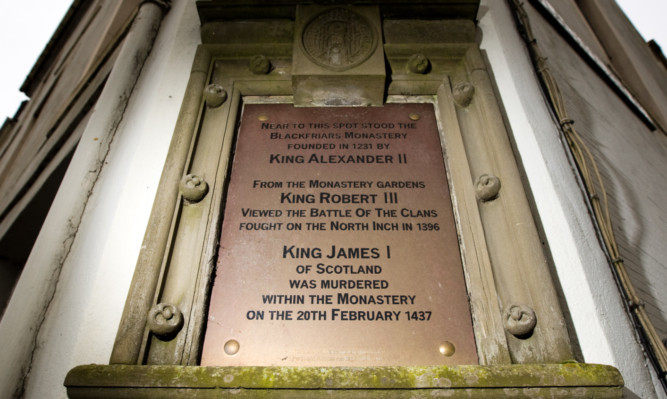A search for the regal victim of a brutal 600-year-old murder could thrust Perth into the international spotlight.
The recent discovery of the remains of Richard III under a Leicester car park captured the imagination of people around the world.
Now, efforts to solve the Fair City’s own royal murder mystery are being championed by history enthusiast and MSP Murdo Fraser.
History records that James I was savagely killed in Perth on February 21 1437 as he hid from assassins, but the exact site of his grave has been lost in the mists of time.
The idea of a quest to discover the last resting place of the murdered monarch has won Mr Fraser’s support.
“Leicester will no doubt benefit from the worldwide attention brought by the exhumation of Richard III,” he said. “A similar project in Perth would have the potential to attract similar global acclaim which can do no harm in promoting the city.
“The story behind the assassination of King James I is well known and historians are almost certain that he lies buried underneath Hospital Street in Perth.
“The logistics behind any disinterment would be considerable. However, if finances can be found, this project would provide historians and archaeologists with another fascinating look into our often bloody past.”
It is known that James I is buried in the grounds of the Carthusian monastery he founded. A memorial at the corner of King Street and Hospital Street marks the fact.
However, the site of the cemetery has been forgotten since the monastery was swept away during the Reformation.
Inspired by the success of the English dig, local history enthusiasts are calling for the money to be found to finance a similar investigation in Perth.
“There are interesting parallels with the discovery of the skeleton of Richard III and the resting place of Scots king James I,” said George McPhee (50), from Perth.
“The Leicester search sounded an impossible task but they proved the doubters wrong. I would love to see the money raised to finance a similar search in Perth.”
While saying that such a search was “plausible”, Perth and Kinross Heritage Trust archaeologist David Strachan expressed caution about the expectations of what it might uncover.
The area of the monastery grounds was quite large, he said, and a lot has been developed over the years. It is now the site of the King James VI Hospital building, tenements, shops, roads and a car park.
Ground-penetrating radar would be required to attempt to identify any burials on accessible areas of ground.
“It could be quite a broad area but a search is entirely plausible,” said Mr Strachan. “You only know when you do it but looking for a skeleton of that period is a bit like looking for a needle in a haystack.
“You could get it but there would be there would be no guarantee of a result.”
The monastic complex in Perth might have seen hundreds of burials and the Richard III search enjoyed a great deal of good fortune, he said.
“It was a remarkable story, particularly as they had a television crew on board when they made this discovery. That is what made it special,” he said.
“They were incredibly lucky with their first trench. In many excavations, what you find is not what you expected.”
Whether a search will be launched is likely to come down to money and no source of funding has yet been identified.
The English dig was paid for by members of the Richard III Society, a group who have fought to rehabilitate the king’s reputation.
rburdge@thecourier.co.uk
